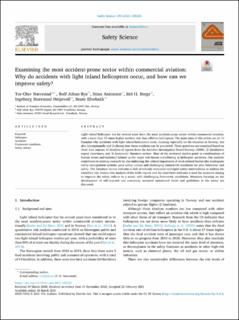| dc.contributor.author | Nævestad, Tor-Olav | |
| dc.contributor.author | Bye, Rolf Johan | |
| dc.contributor.author | Antonsen, Stian | |
| dc.contributor.author | Berge, Siri Hegna | |
| dc.contributor.author | Hesjevoll, Ingeborg Storesund | |
| dc.contributor.author | Elvebakk, Beate | |
| dc.date.accessioned | 2021-04-27T08:16:07Z | |
| dc.date.available | 2021-04-27T08:16:07Z | |
| dc.date.created | 2021-04-13T10:51:44Z | |
| dc.date.issued | 2021 | |
| dc.identifier.citation | Safety Science. 2021, 139, . | en_US |
| dc.identifier.issn | 0925-7535 | |
| dc.identifier.uri | https://hdl.handle.net/11250/2739804 | |
| dc.description.abstract | Light inland helicopter has for several years been the most accident-prone sector within commercial aviation, with a more than 10 times higher accident risk than offshore helicopters. The main aims of this article are to: 1) Examine why accidents with light inland helicopters occur, focusing especially on the situation in Norway, but also internationally and 2) discuss how these accidents can be prevented. These questions are examined based on three data sources: 1) Analysis of reports from the Accident Investigation Board Norway (AIBN), 2) Qualitative expert interviews, and 3) Systematic literature review. Most of the reviewed studies point to combinations of human errors and technical failures as the major risk factors contributing to helicopter accidents. Our analysis contributes to existing research by also indicating the critical importance of work-related factors like inadequate safety management systems, poor safety culture and challenging framework conditions for pilot behaviour and safety. The literature review indicates a lack of robustly evaluated helicopter safety interventions to address the identified risk factors. Our analysis of the AIBN reports and the interviews indicates a need for measures aiming to improve the safety culture in a sector with challenging framework conditions. Measures focusing on the development of self-imposed and commonly accepted operational limits and guidelines in the sector are discussed. | en_US |
| dc.language.iso | eng | en_US |
| dc.publisher | Elsevier Science | en_US |
| dc.rights | Navngivelse 4.0 Internasjonal | * |
| dc.rights.uri | http://creativecommons.org/licenses/by/4.0/deed.no | * |
| dc.title | Examining the most accident-prone sector within commercial aviation: Why do accidents with light inland helicopters occur, and how can we improve safety? | en_US |
| dc.type | Peer reviewed | en_US |
| dc.type | Journal article | en_US |
| dc.description.version | publishedVersion | en_US |
| dc.source.volume | 139 | en_US |
| dc.source.journal | Safety Science | en_US |
| dc.source.issue | July 2021 | en_US |
| dc.identifier.doi | 10.1016/j.ssci.2021.105235 | |
| dc.identifier.cristin | 1903736 | |
| dc.relation.project | Norges forskningsråd: 236643 | en_US |
| dc.description.localcode | This is an open access article distributed under the terms of the Creative Commons CC-BY license, which permits unrestricted use, distribution, and reproduction in any medium, provided the original work is properly cited. | en_US |
| dc.source.articlenumber | 105235 | en_US |
| cristin.ispublished | true | |
| cristin.fulltext | original | |
| cristin.qualitycode | 2 | |

